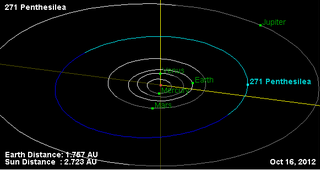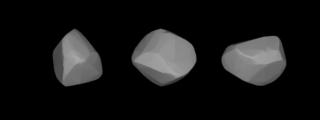Related Research Articles

Lachesis is a large main-belt asteroid. It was discovered by French astronomer Alphonse Borrelly on April 10, 1872, and independently by German-American astronomer Christian Heinrich Friedrich Peters on April 11, 1872, then named after Lachesis, one of the Moirai, or Fates, in Greek mythology. A Lachesean occultation of a star occurred in 1999 and was confirmed visually by five observers and once photoelectrically, with the chords yielding an estimated elliptical cross-section of 184 × 144 km.

Dejanira is a main belt asteroid that was discovered by Alphonse Borrelly on 1 December 1875, and named after the warlike princess Deianira in Greek mythology. The Dejanira family of asteroids is named after it.

Weringia is a typical main-belt asteroid. It was discovered by Johann Palisa on 19 July 1882, and was named after Währing, part of Vienna, the city where the asteroid was discovered. Photometric observations during 2008 showed a rotation period of 11.1496 ± 0.0009 hours and a brightness variation of 0.20 ± 0.02 in magnitude.

Adrastea is a main belt asteroid. It was discovered by Johann Palisa on 18 August 1884 in Vienna, and was named after the Greek nymph Adrasteia. This asteroid is orbiting the Sun at a distance of 2.97 AU with a period of 5.11 years and an eccentricity (ovalness) of 0.23. The orbital plane is tilted at an angle of 6.17° to the plane of the ecliptic.
Walpurga is a large Main belt asteroid. It was discovered by Johann Palisa on 3 April 1886 in Vienna and was named after Saint Walburga.

Libussa is a Main belt asteroid that was discovered by C. H. F. Peters on December 22, 1886, in Clinton, New York and was named after Libussa, the legendary founder of Prague. It is classified as an S-type asteroid.

Penthesilea is a mid-sized main belt asteroid that was discovered by Viktor Knorre on 13 October 1887 in Berlin. It was his last asteroid discovery. The asteroid was named after Penthesilea, the mythical Greek queen of the Amazons.

Bruna is a main belt asteroid that was discovered on 20 March 1890 by Johann Palisa, an Austrian astronomer at the Vienna Observatory.

Delia is a large Main belt asteroid. It was discovered by the French astronomer Auguste Charlois on 30 November 1894 in Nice. "Delia" is an epithet for the ancient Greco-Roman Moon goddess Artemis, for her birthplace at Delos. This asteroid is orbiting the Sun at a distance of 2.79 AU with an orbital eccentricity (ovalness) of 0.085 and a period of 4.64 yr. The orbital plane is tilted at an angle of 3.35° to the plane of the ecliptic.

402 Chloë is a large main-belt asteroid. It was discovered by French astronomer Auguste Charlois on 21 March 1895 from Nice. This asteroid is orbiting the Sun at a distance of 2.56 AU with a period of 4.09 years and an eccentricity of 0.11. The orbital plane is inclined at an angle of 11.8° to the plane of the ecliptic.
Cheruskia is a minor planet, specifically an asteroid orbiting in the asteroid belt that was discovered by German astronomer Paul Götz on 26 July 1905 from Heidelberg.
618 Elfriede is a minor planet orbiting the Sun. On July 24, 2013, it occulted the magnitude 12.8 star 2UCAC 23949304, over parts of Mexico and southwestern United States.
677 Aaltje is a main-belt minor planet orbiting the Sun, discovered by August Kopff at Heidelberg on January 18, 1909. It was named after the Dutch singer Aaltje Noordewier-Reddingius.

708 Raphaela is a minor planet orbiting the Sun.
718 Erida is a minor planet orbiting the Sun. It was discovered at Vienna on September 29, 1911, by Austrian astronomer Johann Palisa, and was named for Erida Leuschner, daughter of astronomer Armin Otto Leuschner. It is orbiting at a distance of 3.06 AU with a period of 5.34 yr and an eccentricity of 0.20. The orbital plane of this asteroid is inclined by an angle of 6.9° to the plane of the ecliptic.
780 Armenia is a minor planet in the asteroid belt orbiting the Sun. It is named after the Kingdom of Armenia, now Armenia. This object is orbiting at a distance of 3.11 AU with an eccentricity of 0.097 and a period of 5.50 yr. The orbital plane is inclined at an angle of 19.1° to the plane of rotation. This asteroid spans a girth of ~94 km. The long rotation period of this asteroid necessitated light curve data from more than one latitude. The overlapping data provided a solution with a period of 19.891±0.002 h and a brightness amplitude of 0.18±0.03 in magnitude.
947 Monterosa is a minor planet orbiting the Sun.
970 Primula is a stony background asteroid from the central regions of the asteroid belt, approximately 9.2 kilometers in diameter. It was discovered on 29 November 1921, by astronomer Karl Reinmuth at the Heidelberg Observatory in southern Germany. The S-type asteroid has a short rotation period of 2.8 hours. It was named after the genus of flowering plants, Primula, which are also known as "primroses".
2311 El Leoncito, provisional designation 1974 TA1, is a dark and reddish asteroid from the outer region of the asteroid belt, approximately 53 kilometers in diameter. The asteroid was discovered by astronomers at Félix Aguilar Observatory at the Leoncito Astronomical Complex in Argentina on 10 October 1974. It was later named after the discovering site.
1921 Pala, provisional designation 1973 SE is a background asteroid in an unstable orbit located in the outer region of asteroid belt, approximately 8.2 kilometers in diameter. It is one of very few bodies located in the 2 : 1 mean motion resonance with Jupiter. It was discovered by Dutch–American astronomer Tom Gehrels at Palomar Observatory on 20 September 1973.
References
- 1 2 "967 Helionape (1921 KV)". JPL Small-Body Database . NASA/Jet Propulsion Laboratory . Retrieved 2 May 2016.
- ↑ Schmadel, Lutz D. (2013). Dictionary of Minor Planet Names. Springer Berlin Heidelberg. p. 135. ISBN 9783662066157.
- ↑ Apostolovska, Gordana; et al. (January 2009). "CCD Photometry of 967 Helionape, 3415 Danby, (85275) 1994 LY, 2007 DT103, and 2007 TU24". The Minor Planet Bulletin. 36 (1): 27–28. Bibcode:2009MPBu...36...27A.